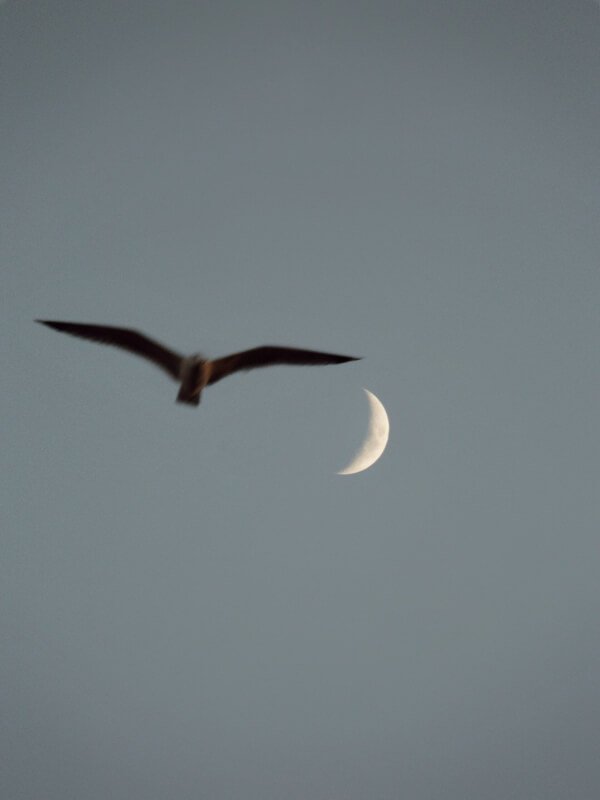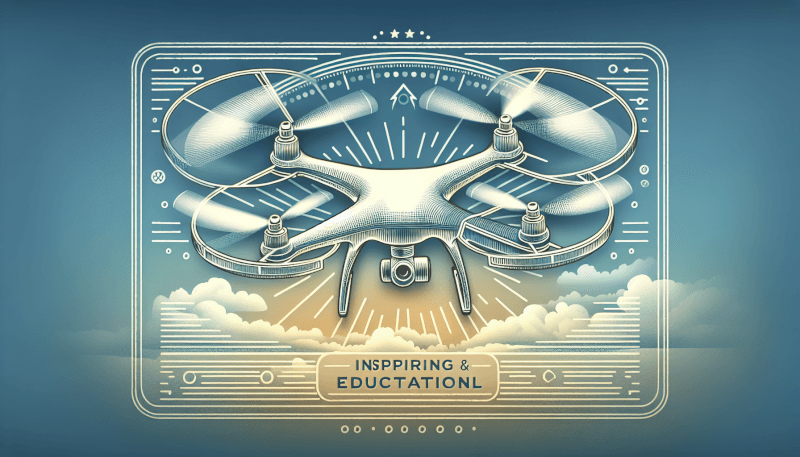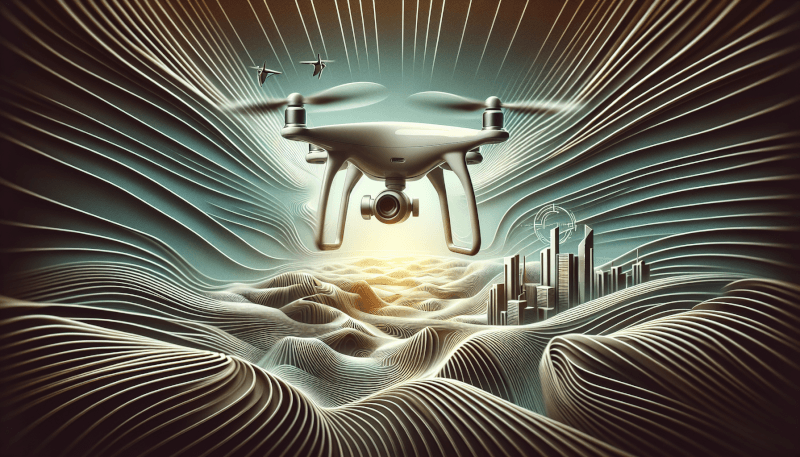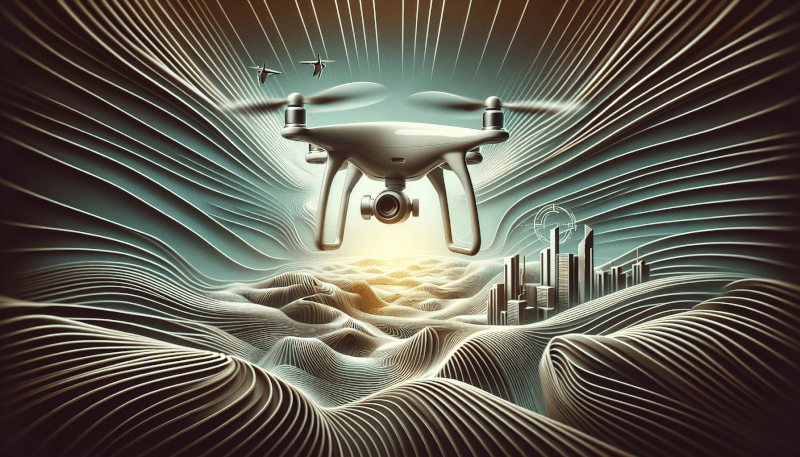If you’ve ever been fascinated by the idea of flying drones, but feel a bit unsure about how to get started, then this beginner’s guide is just for you. In this article, we will provide you with valuable tips and essential guidelines to ensure that you can fly your drone safely and responsibly. Whether you’re a complete novice or have some experience, this guide will equip you with the knowledge and confidence to take to the skies with your drone. So let’s get ready for an exciting journey as we uncover the key principles of flying drones safely.

Drone Basics
Understanding the Parts of a Drone
When it comes to understanding drones, it’s important to familiarize yourself with the key parts that make up these incredible flying machines. Drones consist of various components, such as the frame, motors, propellers, flight controller, and battery. The frame serves as the structure that holds everything together, while the motors and propellers are responsible for generating the necessary thrust for flight. The flight controller acts as the brain of the drone, ensuring stability and enabling the pilot to maneuver the aircraft. Lastly, the battery supplies the power needed to keep the drone airborne.
Different Types of Drones
Drones come in various types, each designed for specific purposes and activities. Let’s take a look at some common types of drones:
Toy Drones: These are entry-level drones, perfect for beginners looking to get a taste of flying. They are usually lightweight, compact, and affordable.
Camera Drones: As the name suggests, camera drones are equipped with high-quality cameras, allowing you to capture stunning aerial photographs and videos. They are popular among enthusiasts and professional photographers.
Racing Drones: Built for speed and agility, racing drones are designed for competitive drone racing. They are lightweight, feature powerful motors, and are equipped with first-person view (FPV) systems for an immersive racing experience.
FPV Drones: FPV drones provide a real-time video feed to the pilot through specialized goggles or screens. This allows you to see what the drone sees, giving you a thrilling and immersive flying experience.
Choosing the Right Drone for Beginners
As a beginner, it is crucial to choose a drone that suits your skill level and meets your needs. Here are some factors to consider when selecting your first drone:
Flight Stability: Look for drones with features like altitude hold and GPS stabilization, as these can make flying easier for beginners.
Durability: Beginners tend to crash their drones more frequently, so it’s essential to choose a durable drone that can withstand some minor collisions.
Ease of Use: Opt for a drone with user-friendly controls and intuitive flight modes. This will help ease the learning curve and make your experience more enjoyable.
Price: Consider your budget and find a drone that offers a good balance between price and features. It’s better to start with a more affordable option while you develop your flying skills.
By considering these factors, you can find a drone that will suit your needs as a beginner pilot and set you on the right path to becoming a skilled and responsible drone operator.
Legality and Regulations
Registering Your Drone
Before you take to the skies with your drone, it’s important to understand the legal requirements and regulations in your country or region. In many countries, drones above a certain weight must be registered with the appropriate aviation authority. This registration process typically involves providing your contact information and the details of your drone. By registering your drone, you can ensure compliance with the law and help authorities in locating your drone in case of any incidents or accidents.
Knowing the Rules and Restrictions
Apart from registering your drone, it’s crucial to familiarize yourself with the rules and restrictions regarding drone operation. These rules may include limits on flying altitude, distance from airports and no-fly zones, and restrictions on flying over people or private property without permission. It’s your responsibility as a drone pilot to know and adhere to these rules to ensure the safety of yourself, others, and any surrounding property.
Understanding No-Fly Zones
No-fly zones are areas where drone operation is strictly prohibited due to safety or security concerns. These zones commonly include areas near airports, military bases, government buildings, and crowded public spaces. It’s vital to familiarize yourself with the designated no-fly zones in your area to avoid any potential legal trouble or endangering others. Many drones have built-in software that prevents them from flying in these restricted areas, but it is still the pilot’s responsibility to exercise caution and respect the regulations.
Pre-Flight Preparation
Finding a Suitable Flying Location
Before taking your drone for a flight, it’s essential to find a suitable location that meets the requirements for safe and enjoyable flying. Look for open spaces away from heavily populated areas, busy roads, and obstacles like trees and power lines. Parks, fields, and open beaches can often be great locations for beginners, as they provide ample space and fewer potential hazards. Avoid flying near airports or other restricted areas, as this can pose significant safety risks.
Checking the Weather Conditions
Weather conditions play a vital role in safe drone operation. Before each flight, it’s important to check the weather forecast, paying attention to factors such as wind speed, rain, and visibility. Strong winds can make it challenging to control your drone and potentially lead to accidents. Rain can damage your drone’s sensitive electronics, and poor visibility may make it difficult to fly safely. It’s always better to err on the side of caution and postpone your flight if the weather conditions are unfavorable.
Inspecting and Maintaining Your Drone
Regular inspection and maintenance of your drone are crucial for safe and reliable operation. Before each flight, carefully inspect your drone for any signs of damage, loose parts, or wear and tear. Ensure that all the propellers are securely fastened and free of debris. Check the battery and connections for any signs of damage or corrosion. By performing these pre-flight checks, you can minimize the risk of mid-air malfunctions or accidents. Additionally, following the manufacturer’s recommended maintenance schedule will help prolong the lifespan of your drone and ensure optimal performance.
Safety Measures
Adhering to a Pre-Flight Checklist
Creating and following a pre-flight checklist is an excellent practice for every drone pilot, regardless of their experience level. A pre-flight checklist helps ensure that you don’t overlook any critical safety procedures before taking off. Your checklist may include items such as checking the battery levels, calibrating the compass, confirming the GPS signal, and verifying that the flight area is clear from obstacles and potential hazards. By consistently following a pre-flight checklist, you can mitigate the risks associated with human error and fly with greater confidence.
Maintaining Line of Sight
Maintaining visual line of sight with your drone is essential for safe and responsible flying. Keep your drone within your line of sight at all times, as this enables you to anticipate and react to any potential obstacles or hazards. Flying beyond your line of sight increases the risk of collisions with other aircraft, objects, or people. Additionally, maintaining line of sight helps you maintain control of your drone, ensuring that you always have a clear understanding of its position and orientation.
Understanding Flight Modes and Limitations
Most drones come equipped with various flight modes and features designed to enhance the flying experience. It’s important to understand the different flight modes and their limitations before using them. Some flight modes, such as “Follow Me” or “Active Track,” allow the drone to track and follow a moving subject automatically. However, it’s crucial to use these modes with caution, ensuring that you have a clear understanding of how they work and the potential risks involved. Always be aware of your surroundings and maintain control of your drone, even when using automated flight modes.

Flying Techniques
Basic Drone Maneuvers
Mastering basic drone maneuvers is essential for safe and precise flying. Here are some fundamental drone maneuvers that every beginner pilot should practice:
Ascending and Descending: Learn how to smoothly ascend and descend your drone to maintain control and ensure stable flight.
Hovering: Practice hovering your drone at various altitudes and positions. This skill is crucial for maintaining stability and capturing steady aerial footage.
Rotation: Practice rotating your drone on its axis to change its direction or capture panoramic shots.
Forward and Backward Flying: Develop the ability to fly your drone forward and backward smoothly, ensuring controlled and precise movements.
Sideways Flying: Mastering sideways flying allows you to capture footage from different angles and navigate tight spaces more effectively.
Mastering the Controls
Understanding and mastering the controls of your drone is key to becoming a skilled pilot. Most drones are operated using a controller or a mobile device with a dedicated app. Familiarize yourself with the various buttons, joysticks, and sliders on the controller, and practice using them to maneuver your drone in a controlled manner. Take the time to understand how each control input affects the drone’s flight, such as throttle, pitch, roll, and yaw. By practicing regularly and developing muscle memory, you’ll gain the dexterity and confidence needed to fly your drone smoothly and precisely.
Avoiding Collisions and Obstacles
Avoiding collisions and obstacles is crucial for both the safety of your drone and the people and property around you. Obstacle avoidance features are becoming increasingly common in modern drones, but it’s always better to rely on your flying skills and situational awareness. Be mindful of objects like trees, buildings, and power lines, ensuring you have enough clearance to maneuver safely. Practice flying in open areas first before attempting flights in more complex environments. By honing your flying techniques and maintaining a vigilant lookout, you can greatly reduce the risk of collisions and incidents.
Flight Safety Tips
Fly in Open Areas with Few People
When flying your drone, it’s best to choose open areas with few people around. Flying in crowded areas can increase the risk of accidents and injuries. Look for parks, fields, or other designated flying locations where you can enjoy the freedom to explore the capabilities of your drone without endangering others. This ensures a safer flying experience and minimizes the potential for disturbances or conflicts with other individuals.
Avoid Flying Near Airports or Military Zones
It’s essential to avoid flying your drone near airports, military bases, or any other areas with restricted airspace. These areas are designated no-fly zones for good reason, as unauthorized drones can pose serious risks to manned aircraft. Flying near airports or military zones is not only illegal but can also result in severe fines or legal consequences. Always check the local regulations and map out the restricted areas before planning your flights.
Stay Away from Power Lines and High Buildings
Power lines and tall buildings can pose a significant risk to your drone. Flying too close to power lines increases the risk of electrical interference and the chance of collision. Similarly, high buildings can disrupt GPS signals and cause turbulence, making it difficult to maintain stable flight. It’s crucial to maintain a safe distance from power lines and give tall buildings a wide berth to prevent any potential accidents or damage to your drone.

Battery and Power Management
Understanding Battery Life and Flight Time
Battery life and flight time are important considerations when operating a drone. Different drones have varying battery capacities, which directly affect how long you can fly before needing to land and recharge. It’s essential to understand the battery life of your specific drone model and plan your flights accordingly. Factors such as wind conditions, flight maneuvers, and payload also impact the drone’s power consumption. By managing your battery usage effectively, you can maximize your flight time and avoid unexpected power loss mid-flight.
Charging and Storing Batteries Safely
Properly charging and storing your drone batteries is vital for their longevity and safe operation. Follow the manufacturer’s guidelines and use the supplied charger or approved third-party chargers specifically designed for your drone’s batteries. Avoid overcharging or leaving batteries unattended while charging to reduce the risk of fire or other safety hazards. When not in use, store your batteries in a cool, dry place away from direct sunlight, extreme temperatures, and flammable materials. Regularly inspect your batteries for signs of damage or swelling, and dispose of them responsibly if they are compromised.
Monitoring Power Levels during Flight
While flying, it’s crucial to monitor your drone’s battery levels to ensure a safe return to the ground. Most drones have battery monitoring features that provide real-time information about remaining power. Pay attention to these notifications and plan your flight to allow a safe margin for returning home without depleting the battery. It’s always better to have extra battery power available to account for unexpected flight extensions or emergencies. If your drone has a return-to-home feature, ensure that it is properly configured and activated to automatically return to its takeoff location when the battery reaches a critical level.
Dealing with Emergencies
Handling Mid-Air Malfunctions
Despite careful pre-flight preparations and regular maintenance, mid-air malfunctions can occur. It’s crucial to remain calm and follow these steps if you encounter an emergency situation while flying your drone:
Stay calm: Panicking can lead to poor decision-making. Stay focused and maintain control over the situation.
Maintain altitude: If you encounter a problem, try to maintain altitude to avoid sudden crashes that could cause further damage.
Assess the situation: Quickly assess the issue and determine the appropriate course of action. This may include troubleshooting, landing in a safe area, or activating an emergency landing mode if available.
Utilize emergency procedures: Familiarize yourself with your drone’s emergency procedures, such as initiating a manual landing or activating fail-safe features.
Land with caution: If possible, aim for a safe landing area away from people, buildings, and obstacles. Take your time and perform a controlled descent to minimize the risk of damage or injury.
Reacting in Strong Winds or Bad Weather
Flying in strong winds or adverse weather conditions can be a challenging and risky endeavor. If you find yourself encountering strong winds or bad weather while flying, here are some steps to take:
Descend to a lower altitude: Strong winds are more prevalent at higher altitudes. Descend to a lower altitude where the wind may be less intense.
Fly against the wind: If possible, fly against the wind to maintain control and prevent the wind from pushing your drone away.
Adjust flight modes: Some drones have specific flight modes designed for windy conditions. Activate these modes if available to enhance stability and control.
Seek shelter: If the weather deteriorates rapidly, seek shelter and land your drone as soon as possible to avoid any potential damage from heavy rain, snow, or other adverse conditions.
Remember, it’s always better to err on the side of caution and postpone your flight if the weather conditions are not suitable for safe and enjoyable flying.
Dealing with Flyaways
A flyaway occurs when an unmanned aircraft unexpectedly loses connection with the controller or experiences a technical glitch, resulting in the drone flying off on its own. Flyaways can be distressing, but it’s important to remain calm and follow these steps:
Activate fail-safe features: If your drone has built-in fail-safe features, activate them immediately. These features can initiate a return-to-home sequence or land the drone safely in the event of a flyaway.
Monitor the drone’s flight path: Observe the direction and altitude of the drone as it flies away. This information can help you track its path and potentially recover it later.
Document the incident: Take note of the surroundings, GPS coordinates, and any other relevant details of the flyaway. This information may assist in locating the drone or filing a warranty claim if applicable.
Contact local authorities if necessary: In cases where the drone flies into prohibited airspace or poses a threat to public safety, contact the local authorities or relevant aviation agency to report the incident.
While flyaways can be frustrating, taking these steps can help increase the chances of locating and recovering your drone or resolving any issues that may have caused the flyaway.

Understanding Photography and Videography
Mastering Aerial Photography Techniques
Drones have revolutionized the world of aerial photography, allowing photographers to capture breathtaking images from unique angles and perspectives. Here are some tips to master aerial photography:
Composition: Pay attention to the principles of composition, such as the rule of thirds and leading lines, to create visually appealing and balanced photographs.
Lighting: Take advantage of the golden hours, the period shortly after sunrise and before sunset, when the light is soft and warm. Experiment with different lighting conditions and angles to achieve desired effects.
Perspective and Scale: Use the unique vantage point of your drone to capture scenes from a perspective that is not easily achievable with traditional photography. Play with the scale by including objects or people in the frame to provide a sense of size and context.
Post-processing: After capturing your aerial photographs, enhance them further using photo editing software. Adjusting exposure, contrast, and color balance can help bring out the best in your aerial shots.
By practicing these techniques and experimenting with different settings and angles, you’ll be able to capture stunning aerial photographs that will take your photography skills to new heights.
Using Camera Settings and Modes
Understanding your drone’s camera settings and modes is crucial for capturing high-quality images and videos. Here are some common camera settings to consider:
White Balance: Adjusting the white balance settings helps ensure accurate color representation in different lighting conditions. Experiment with different presets or use a custom white balance setting for optimal results.
Shutter Speed: Controlling the shutter speed allows you to capture motion effectively, whether you want to freeze the action or create motion blur for artistic effect.
ISO: Adjusting the ISO sensitivity helps you capture sharp and well-exposed images in varying light conditions. However, be mindful of noise and grain that can occur at higher ISO settings.
Exposure Compensation: Use exposure compensation to adjust the overall brightness of your images. Increase it for darker scenes and decrease it for brighter scenes to achieve the desired exposure.
Additionally, familiarize yourself with your drone’s intelligent flight modes, such as Point of Interest or Waypoints, which can automate certain camera movements and create dynamic shots. Experimenting with these settings and modes will allow you to unleash your creativity and capture stunning aerial footage.
Editing and Storing Footage
After capturing your aerial footage, post-processing and storing it properly are essential for preserving its quality and ensuring convenient access. Here are some tips for editing and storing your footage:
Post-processing: Transfer your footage to a computer and use video editing software to refine and enhance the footage. Trim clips, adjust color grading, add music or voiceovers, and bring your footage to life.
File Organization: Maintain an organized file structure to store your footage. Create folders or directories categorized by date, location, or specific projects to easily locate and retrieve your footage when needed.
Backup Solutions: Establish a backup system to protect your footage from loss or damage. Consider multiple storage options, such as external hard drives, cloud storage, or dedicated backup services.
Sharing and Distribution: Once you have edited your footage, consider sharing it with others or showcasing it on social media platforms or video hosting websites. Be cautious, however, about sharing footage that may compromise privacy or violate ethical guidelines (more on that in the next section).
By dedicating time to editing and organizing your footage, you can preserve your aerial memories and easily share them with others.
Respecting Privacy and Ethics
Obtaining Consent for Filming in Public Areas
Respecting the privacy and rights of individuals is of utmost importance when flying drones. In public areas, it’s generally permissible to film people without their consent as long as their privacy is not significantly compromised. However, it’s always a good practice to obtain consent when filming people in public, especially when focusing on individuals or capturing footage in more intimate settings. Be courteous and transparent about your intentions, and respect anyone’s wishes if they do not want to be filmed.
Respecting Personal Space and Privacy
When flying drones, it’s crucial to respect personal space and avoid intruding upon others’ privacy. Maintain a safe distance from people, property, and private areas to avoid causing discomfort or capturing footage that may infringe upon privacy rights. If you need to film in private areas, such as gardens or residential properties, always seek permission from the property owner before doing so. Respecting personal space and privacy ensures a positive and responsible drone flying experience for everyone involved.
Understanding Ethical Drone Use
Ethical drone use goes beyond legal and regulatory requirements and encompasses a set of principles that promote responsible, considerate, and safe drone operation. Some key principles of ethical drone use include:
Safety: Prioritize the safety of yourself, others, and any surrounding property over capturing footage or pushing the limits of your drone’s capabilities.
Respect: Respect the rights, privacy, and personal space of individuals, and do not use your drone to harass or invade the privacy of others.
Conservation: Avoid flying over protected or sensitive areas, such as wildlife habitats or cultural sites, that may be disrupted or damaged by drone operations.
Noise Pollution: Be mindful of the noise generated by your drone, especially in residential areas or natural environments where tranquility should be maintained.
By adhering to these ethical guidelines, you can contribute to a positive drone community and help shape a culture of responsible and respectful drone use.
In conclusion, flying drones can provide an exhilarating and rewarding experience. By understanding the basics of drones, following legal requirements and safety regulations, and practicing responsible flying techniques, you can enjoy the thrill of flight while ensuring the safety of yourself, others, and the environment. Remember to always fly with caution, respect privacy and ethics, and embrace the art of capturing stunning aerial imagery. Happy flying!



